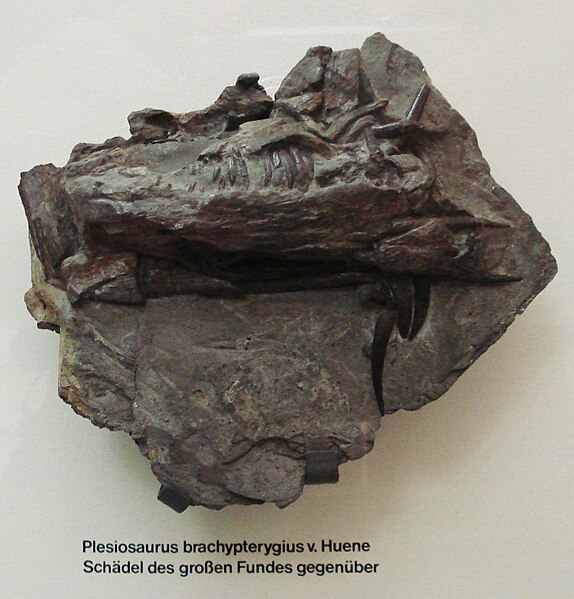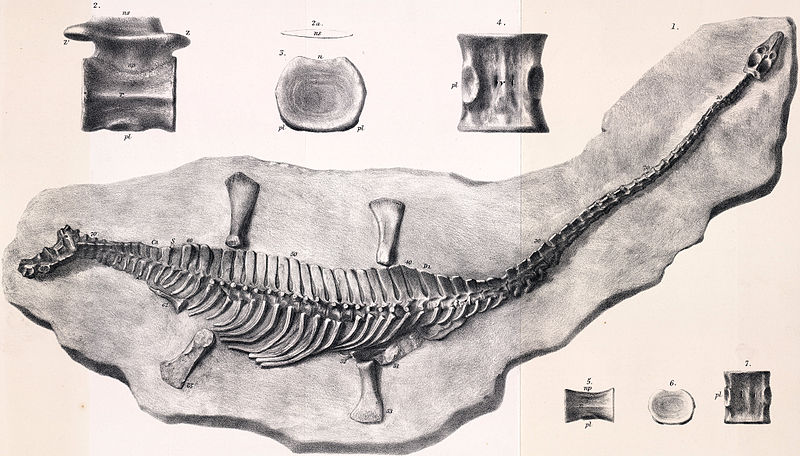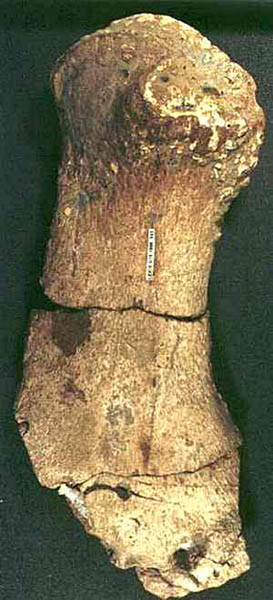[Recent Entries][Archive][Friends][User Info]
April 25th, 2012
| April 25th, 2012 | |
|---|---|
| 06:19 pm [industrialterro] [Link] |
Gallardosaurus Gallardosaurus is a genus of pliosaurid plesiosaur from the Caribbean seaway. It contains the single species Gallardosaurus iturraldei. Gallardosaurus was found in middle-late Oxfordian-age (Late Jurassic) rocks of the Jagua Formation of western Cuba. Gallardosaurus is believed to be evolutionarily connected to Peloneustes, a pliosaurid commonly found in the Oxfordian-aged sediment. Oxfordian-age reptiles have been found in Cuba since the first half of the 20th century, but most have not received wide recognition because publications were not widely disseminated. In 1996, Dr. Manuel Iturralde-Vinent and Mark Norell initially mentioned specimen MNHNCu P3005, a partial skull and mandible with a few cervical vertebrae, as resembling that of the species Pliosaurus ferox. The specimen had been discovered in 1946 by Cuban farmer Juan Gallardo about 8 kilometres (5.0 mi) east of Viñales, Pinar del Río, northwestern Cuba. However, it was not prepared when Iturralde-Vinent and Norell saw it and a full description was not made. After preparation, Zulma Gasparini and Iturralde-Vinent assigned the specimen to the genus Peloneustes in 2006, but it was later determined that the specimen was that of a new genus. In 2009, MNHNCu P3005 was described as a separate genus, Gallardosaurus. The generic name is derived from the specimen MNHNCu P3005's discoverer, Juan Gallardo, who together with Juanito Gallardo is credited with discovering most of the Oxfordian reptiles in Cuba. The species name G. itturraldei is derived from the name of the geotectonist and paleontologist Dr. Manuel Iturralde-Vinent. MNHNCu P3005 was found in a concretion in dark shale, within the Jagua Vieja Member of the Jagua Formation. It is preserved three-dimensionally with slight deformation. The tip of the snout and the posterior ends of the lower jaw are absent. The skull was broad and not tall, with long pointed teeth. The lack of fusion in some of the vertebrae suggests the individual was not fully grown when it died. G. iturraldei would probably have seasonally migrated across the Caribbean Seaway, and would have preyed mostly on nectonic fish that dwelt in the region in which it existed. Also known from the Jagua Vieja Member are ichthyosaurs, the marine turtle Caribemys oxfordiensis, and the plesiosauroid Vinialesaurus caroli. The water depth was shallow, perhaps 10 to 12 metres (33 to 39 ft) deep, and oysters and algae colonized the sea bottom. Fragmentary remains of plants, pterosaurs, and dinosaurs arrived from nearby coastal areas.
Tags: Вымершие рептилии, Юра, диапсиды, завроптеригии, лепидозавроморфы, плезиозавры, плиозавриды, плиозавры |
| Time | Event |
| 06:39 pm [industrialterro] [Link] |
Hauffiosaurus Hauffiosaurus is an extinct genus of Early Jurassic (early Toarcian stage) pliosaurid plesiosaur known from Holzmaden of Germany and from Yorkshire of the United Kingdom. It was first named by Frank Robin O’Keefe in 2001 and the type species is Hauffiosaurus zanoni. In 2011, two additional species were assigned to this genus: H. longirostris and H. tomistomimus. Hauffiosaurus is known from the holotype and only specimen uncataloged Hauff Museum, an almost complete and articulated skeleton, found from the Posidonien-Schiefer, dating to early Toarcian stage of the Early Jurassic. The holotype specimen preserved in a single block of the original matrix, exposed in ventral view. The body outline visible around the specimen is an artifact of preparation, not preservation; no remains of soft tissue were preserved. The skeleton was discovered during the early 19th Century, in beds of the famous Posidonien-Schiefer lagerstätte at Holzmaden, Baden-Württemberg, in southeastern Germany. However, it was not recognized as a valid taxon, and no thorough description of the fossil was made until 2001. Hauffiosaurus zanoni is a plesiosaur of medium size, measuring 3.4 metres (11 ft). The skull measures about 430 millimetres (1 ft) along the midline. The holotype is an adult individual, but incomplete fusion of the pectoral and pelvic girdle indicate it's not an old adult. The specimen is displayed at the Urwelt-Museum Hauff, Holzmaden. The exact phylogenetic position of Hauffiosaurus within the Plesiosauria has yet to resolved, though Vincent (2011) states that it may "reasonably be placed within the Pliosauroidea". A second species, H. tomistomimus, was named by Roger B. J. Benson, Hilary F. Ketchum, Leslie F. Noè and Marcela Gómez-Pérez in 2011. It is known from the holotype and only specimen, MMUM LL 8004, an almost complete, three-dimensionally preservedand and articulated skeleton, found from the Hildoceras bifrons Zone of the Alum Shale Member, Whitby Limestone Formation, dating to early Toarcian stage. This skeleton was discovered in Yorkshire, UK. The holotype H. tomistomimus is about 4.83 metres (16 ft) long. Benson et al. 2011 reassigned Macroplata longirostris (originally Plesiosaurus longirostris) to Hauffiosaurus. The holotype and only specimen of H. longirostris, MCZ 1033, found from the Harpoceras serpentinum Zone of the Alum Shale Member, Whitby Limestone Formation, early Toarcian of Yorkshire, England. Few Early Jurassic plesiosaurians have the sort of long, thin snout present in Hauffiosaurus, a shape usually considered to indicate a diet of fish (ichthyophagy). The teeth are slender and elongated and possess fine longitudinal ridges. This sort of tooth, coupled with the long rostrum seen in this genus is effective in piercing soft prey.
Tags: Вымершие рептилии, Юра, диапсиды, завроптеригии, лепидозавроморфы, плезиозавры, плиозавриды, плиозавры |
| Time | Event |
| 06:54 pm [industrialterro] [Link] |
Hydrorion Hydrorion (meaning 'water hunter') is an extinct genus of plesiosaur. It was found in Jurassic formations in Germany. The only species is Hydrorion brachypterygius.
Tags: Вымершие рептилии, Юра, диапсиды, завроптеригии, лепидозавроморфы, плезиозавриды, плезиозавроиды, плезиозавры |
| Time | Event |
| 07:05 pm [industrialterro] [Link] |
Macroplata Macroplata (mack-roh-PLAH-tah), meaning, (big plate), is an extinct genus of Early Jurassic basal plesiosaur which grew up to 4.5 metres (15 ft) in length. Like other plesiosaurs, Macroplata probably lived on a diet of fish, using its sharp needle-like teeth to catch prey. Its shoulder bones were fairly large, indicating a powerful forward stroke for fast swimming. Macroplata also had a relatively long neck, twice the length of the skull, in contrast to pliosaurs. Two species are currently included in this genus: Macroplata tenuiceps, the type species, which lived during the Hettangian age (earliest Jurassic), and Macroplata longirostris, which lived somewhat later, during the Toarcian. However, it is thought that M. longirostris may be a distinct form that should be placed in a separate genus. In 2011, M. longirostris became a new species of Hauffiosaurus, so "M. longirostris" is now H. longirostris.
Размеры тела в сравнении с человеком:
Tags: Вымершие рептилии, Юра, диапсиды, завроптеригии, лепидозавроморфы, плезиозавры |
| Time | Event |
| 07:15 pm [industrialterro] [Link] |
Microcleidus Microcleidus is an extinct genus of sauropterygian reptile belonging to the plesiosaur suborder. It was about the size of a medium sized dolphin, reaching a length of 3 metres (9.8 ft). Species include: Microcleidus homalospondylus (Owen 1865) and Microcleidus macropterus (Seeley 1865). The species has 40 neck vertebrae and a short tail of 28 vertebrae.
Tags: Вымершие рептилии, Юра, диапсиды, завроптеригии, лепидозавроморфы, плезиозавроиды, плезиозавры |
| Time | Event |
| 07:22 pm [industrialterro] [Link] |
Muraenosaurus Муренозавр (Muraenosaurus) - род позднеюрских плезиозавров обитавших на территории современной Европы. Останки найдены в Англии, Франции, России. Животные достигали в длину приблизительно 6 метров и вели хищный образ жизни, питаясь, по большей части, рыбой. Хотя муренозавр известен, главным образом, по окаменелостям, найденным в Англии, очень сходные остатки были найдены в России, а также в Северной и Южной Америке. Весьма вероятно, что океанские животные такого типа существовали по всему миру. Хотя это был довольно крупный плезиозавр (длиной до 6 метров), один вид муренозавра - М. beloclis, отличался небольшими размерами: всего 2,5 м. Характеристики: шея муренозавра равна по длине телу и хвосту, вместе взятым, в ней 44 позвонка, крошечная голова занимает всего одну шестнадцатую часть длины всего животного. Голова довольно широкая, с коротким рылом. Зуб - от 19 до 22 пар на каждой челюсти, постепенно укрупняются к передней части пасти. Muraenosaurus grew to around 6 metres (20 ft) long, with around half of that length being taken up by the animal's neck, which possessed 44 vertebrae. Behind the neck, Muraenosaurus had a short, relatively inflexible body and powerful flippers. The head was remarkably small compared to the overall size of the animal, being only around 37 centimetres (15 in) long.
Размеры тела в сравнении с человеком (немного преувеличено):
Tags: Вымершие рептилии, Юра, диапсиды, завроптеригии, криптоклидиды, лепидозавроморфы, плезиозавроиды, плезиозавры |
| Previous Day | 2012/04/25 [Archive] |
Next Day |






















